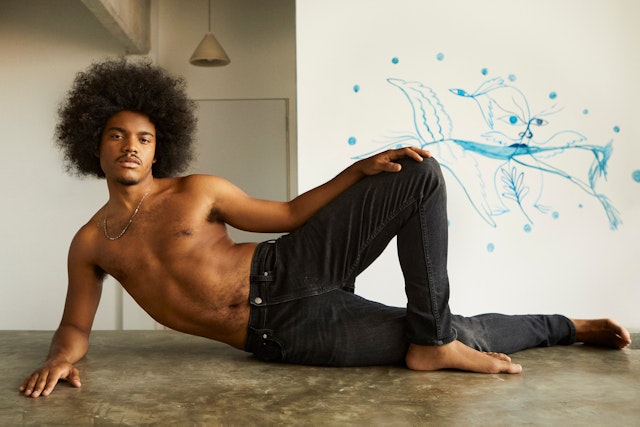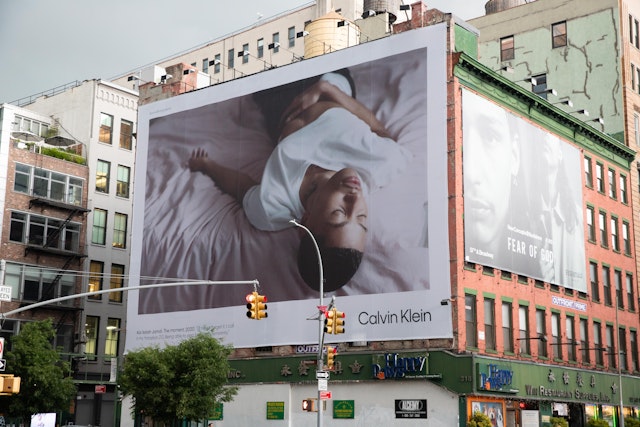Calvin Klein’s CMO on redefining sexuality: ‘Inclusivity is an iconic element of the brand’
On the tail end of Calvin Klein’s 2021 Pride campaign, global chief marketing officer Linh Peters opens up to The Drum about how the brand is expanding what sex and sensuality look like – while maintaining its signature focus on cultural relevance.

Indie pop musician King Princess was one of the key faces of Calvin Klein's latest Pride campaign
Calvin Klein, over the course of the last half century, has come to be nearly synonymous with American designer fashion – and at times synonymous with advertising’s longtime obsession with hypersexuality. Today the brand, whose classic cotton underwear is ubiquitous on the racks of Urban Outfitters and other popular retailers as well as the Instagram posts of both influencers and regular consumers, has struck a new tune. But it’s not straying too far from its roots as a brand on the pulse of every cultural moment.
“You think about 10 or 20 years ago and our creative was really at the forefront of perceived sexuality and sensuality, and that evocative campaign imagery,” says Linh Peters, who was appointed global chief marketing officer in November of last year. “Even though that has shifted in terms of what that looks like, at the heart of it, it’s still really about redefining what sexuality and sensuality means. It’s [redefining] gender, it’s inclusivity. It’s expanding what that definition is and being that platform for customers to express themselves.”
Indeed, the brand has a long and well-documented history of advertising with overt and even boundary-pushing sexually-charged imagery. Its brand marketing has been itself the subject of controversy as far back as 1980, when a 15-year-old Brooke Shields appeared in a television ad with the tagline, “You want to know what comes between me and my Calvins? Nothing.” The spot was pulled by CBS. In 2009, billboards depicting what some described as a scene suggestive of group sex or a ‘gang rape’ were torn down in New York, while the Australian Advertising Standards Bureau banned the ad in the country altogether, asserting that it was ‘suggestive of violence and rape’.
Similarly, scandalous stunts have caused shockwaves as recently as 2015, when a joint Calvin Klein-Tinder campaign that glamorized sexting caused an outcry. The brand’s former chief marketer Melisa Goldie told WWD in 2016: “We just want to be at the center of culture, and sometimes culture can be controversial.”
And even amid controversy, the brand always managed to do just that: tap into the zeitgeist in memorable ways. Its spring 2015 ads starring a shirtless Justin Bieber took the world by storm. The following year the brand took home a Fashion Media Award (FMA) for Ad Campaign of the Year – its viral #mycalvins campaign, which starred a diverse cast of actors, musicians, athletes and models. Then, in 2017, the brand made a splash with a bold men’s campaign championing the cast of Academy Award-winning film Moonlight.
Dialing up diversity and inclusion
It’s clear that in recent years, the brand has maintained its cultural capital while shifting its focus to promote more inclusive and diverse representations of sexuality, rather than overt hypersexualization. Peters says the brand is increasingly focused on creating broader definitions of sexuality and gender expression. In fact, it just wrapped #proudinmycalvins, its 2021 Pride campaign featuring a range of LGBT+ faces – including makeup artist Raisa Flowers, indie pop star King Princess and Spanish actor Omar Ayuso – sharing the powerful moments in their lives that defined their journey.
LGBT+ support and advocacy in particular is becoming an increasingly important keystone of Calvin Klein’s brand and messaging. “Brands sometimes get dinged for being very commercially-focused on Pride,” says Peters. “It’s like, it’s great that you guys support Pride, but what else are you guys doing during the rest of the year? [Pride has] become less about a campaign [or month in the year] ... it’s always a part of who we are. We are shifting in terms of really thinking through, ‘How we always show up as a brand that supports the LGBT+ community? How do we think about using our platform to give those consumers a voice and an opportunity to tell their story?’” She says that this year’s campaign was about creating a platform by which both brand talent and consumers of Calvin Klein could feel free to express themselves.

Peters also stresses that the brand is seeking to expand its definitions of sexuality and sensuality by maintaining its signature youthful energy but creating a broad appeal. “The iconic elements of the brand ... [are] inclusivity, avant-garde, youthfulness.” This youthfulness, according to Peters, is more an attitude than an arrow aimed at young people. “[Our target audience member] could be somebody who’s 19 or somebody who’s 55.”
Keeping outdoor advertising fashionable
The past year and a half has forced Calvin Klein, like almost all fashion brands and retailers, to adapt in significant ways. Not only did the brand have to navigate the complex landscape of differing Covid restrictions in various markets around the world – which impacted its commerce and business strategies – but it also had to adjust its marketing efforts.
The brand homed in on digital and social channels but, to the surprise of some, continued to invest in out-of-home advertising (OOH) – a channel in which Calvin Klein has been a major player essentially since its inception. And although consumers around the globe were leaving their homes far less frequently than usual, Peters believes that maintaining the mix of digital and OOH was key to Calvin Klein’s success during this pandemic and will continue to be a focus for the brand moving forward.

“For any brand that’s going to be successful nowadays – especially when it comes to marketing and driving engagement – you really have to be where the consumer is,” she says. “For us, there’s a heavy emphasis on digital and social media, but at the same time, there’s really some iconic elements to the brand. I don’t know that there are many brands that still consider billboards to be a key component of their go-to-market strategy, but for us, because of our place in cities like New York and Los Angeles and around the world, we are very purposeful about making sure that that is a component of our go-to-market strategy.
“It’s true to who we are ... it’s really about creating a conversation; it’s really about getting a reaction from our customers. There’s always an opportunity for us to create engagement, to give our consumers pause, to get them to ask questions.”
And aside from investing more deeply in its marketing mix, Calvin Klein has also ventured into new territory. This April, the brand kicked off a partnership with artist and designer Heron Preston. “Inspired by traditions of utility and performance,” the new collection entails elevated wardrobe basics. The project is Calvin Klein’s first designer collaboration. “It wasn’t just about partnering with Heron Preston to design clothes,” says Peters. “It was really a 360° collaboration in terms of the product, our marketing, how we go to market and the overall customer experience. For us, it was a tremendous success in terms of driving brand relevancy and driving awareness and engagement with a new type of customer.”
And the brand’s efforts are paying off: PVH Corp, the brand’s parent company, reported that Calvin Klein saw a 65% spike in business in Q1 of 2021 compared to the same period last year, including a 91% increase in international revenue and a 27% lift in North American revenue.
According to Peters, the future looks bright. “There’s so much love and passion for this brand that our customers have. [My goal is to make] sure that we are bringing that back to a place where it’s really coming through in the entirety of the customer experience – through the product, the marketing and how you engage with us across our different channels.”

